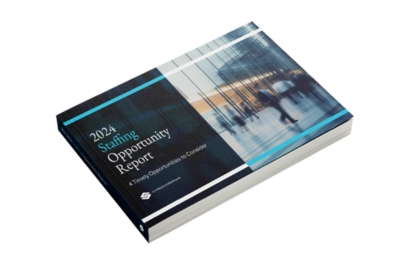Streamlining Costs: Effective Realignment Tactics for Staffing Firms
The Need for Cost Control
Staffing firms face unique challenges, such as variable demand, talent shortages, and compliance requirements. These factors can lead to unpredictable costs, making it essential for firms to implement effective cost control measures. By doing so, staffing firms can better manage their resources and remain competitive in today's market. Cost control provides a buffer against economic volatility, allowing firms to maintain steady operations even when external conditions are less than favorable. In these uncertain times, with constant pressure on bill rates and profitability, cost control is more important than ever for many staffing firms.
In addition, effective cost control can enhance a firm's reputation among clients and candidates, relieve pressure on the bottom line, and allow owners to make investments to grow revenues. When a staffing firm demonstrates financial prudence, it builds trust with stakeholders, who can be confident in the firm's stability and reliability. This trust can translate into stronger client relationships and an enhanced ability to attract top talent, further bolstering the firm's market position.
Identifying Key Cost Drivers
To realign operating costs effectively, staffing firms must first identify their key cost drivers. These may include:
- Personnel Costs: Salaries, benefits, and training expenses for both permanent and temporary staff. Personnel costs often represent the largest share of a staffing firm's budget, necessitating careful analysis and strategic management to ensure alignment with business needs. Many staffing firms have not focused on these costs, and many need to re-align their internal staff with the decline in revenues. Also, there are opportunities to implement technology to lower personnel costs.
- Operational Expenses: Office rent, utilities, and administrative costs. These expenses, while essential, can often be optimized through strategic negotiations and efficiency improvements.
- Technology Costs: Software, hardware, and IT support. Technology investments should be closely aligned with business goals to ensure they provide the best return on investment. Many staffing firms are using AI to take the place of simple tasks, managing communications with candidates and better aligning the candidate with customers.
- Compliance and Regulatory Costs: Licensing fees and costs associated with meeting industry regulations. Staying ahead of regulatory changes can prevent costly penalties and ensure that operations run smoothly
By understanding these cost drivers, staffing firms can prioritize their cost reduction efforts, focusing on areas with the greatest potential impact. This targeted approach ensures that resources are allocated effectively, maximizing the benefits of cost realignment initiatives.
Cost Reduction Tactics for Staffing Firms
Once key cost drivers are identified, staffing firms can implement targeted cost reduction tactics including:
Streamlining Personnel and Operational Costs
Personnel and operational costs often represent a significant portion of a staffing firm's operating expenses. To manage these costs effectively, consider:
- Optimizing Staffing Levels: Use data analytics to forecast demand and adjust staffing levels accordingly. This ensures you have the right number of employees without overstaffing or understaffing, which can be a drain on resources.
- Leveraging Temporary Staff: Use temporary staff to fill short-term needs without committing to long-term expenses associated with permanent hires. This flexibility allows firms to respond quickly to changes in demand without incurring unnecessary costs.
- Investing in Training: Crosstrain employees to perform multiple roles, increasing flexibility and reducing the need for additional hires. This not only optimizes workforce utilization but also enhances employee engagement and retention by providing career development opportunities.
- Negotiating with Vendors: Regularly review vendor contracts and negotiate better terms to reduce costs. Building strong relationships with vendors can lead to more favorable terms and conditions, providing significant cost savings over time.
- Implementing Remote or Hybrid Work: Encourage remote or hybrid work to reduce office space requirements and associated costs like utilities and supplies. A well-implemented remote or hybrid work strategy can also enhance employee satisfaction in today’s competitive market.
Optimize Technology Investments
Technology is a critical component of successful staffing firms, but it can also come at a significant cost. Consider these strategies:
- Use Cloud Solutions: Transition to cloud-based software to reduce hardware and maintenance costs while improving scalability and flexibility. Cloud solutions can also enhance collaboration and data accessibility, supporting more efficient operations.
- Regularly Review Subscriptions: Audit software subscriptions to ensure you're only paying for what you need and use. This can prevent unnecessary expenditures and ensure that technology investments are aligned with business priorities.
- Invest in Artificial Intelligence (AI) Tools and Digital Automation: When properly implemented, AI and digital automation can be powerful tools to streamline repetitive tasks, such as payroll processing and candidate tracking, reducing labor costs, and improving data accuracy. Automation frees up valuable staff time for more strategic activities, enhancing overall productivity. Though there is an associated cost with investing in these technologies, the return on investment (ROI) is often favorable.
Manage Compliance and Regulatory Costs
Compliance is non-negotiable in the staffing industry. Managing these costs effectively includes:
- Staying Informed: Keep up to date with regulatory changes to avoid fines and penalties that can arise from non-compliance. Proactive compliance management can prevent costly disruptions and protect the firm's reputation.
- Using Compliance Software: Invest in software that helps manage compliance requirements, reducing the risk of errors and associated costs. Enterprise resource planning (ERP) systems are crucial to allowing a firm to streamline compliance processes and ensure that all requirements are consistently met.
- Conducting Regular Audits: Perform regular audits to identify and address compliance gaps proactively. Regular reviews help maintain compliance standards and can reveal opportunities for further cost savings through improved processes.
Implementing an Effective Strategy
It is vitally important to understand how your organization stacks up against its industry peers – where is your enterprise spending outsized dollars versus the industry? Is your compensation structure in line with the industry? How are your profit margins? Is the internal employee headcount appropriate for the size of your business? Are these areas in which savings could be achieved? It is important to consult with professionals who have a deep understanding of the staffing industry to help you evaluate where you stand and highlight opportunities for savings.
A valuable tool for monitoring and cost containment is a robust budgeting process — budgeting at the start of the year — and monthly analysis of budget versus actual to identify anomalies, and to offer a timely mechanism to halt unnecessary outflows.
Regularly monitor the results of your cost realignment efforts. Use key performance indicators (KPIs) to measure success and make adjustments as needed to stay on track. Continuous monitoring ensures that cost reduction initiatives remain effective and responsive to changing conditions.
Encourage feedback from team members to identify areas for further improvement. This ongoing dialogue fosters a culture of adaptability and ensures that the firm remains agile in its cost management practices.
How Citrin Cooperman Can Help
In today's dynamic market, staying agile and proactive in managing costs will position your staffing firm for growth and success in the years to come. Realigning operating costs is essential for maintaining competitiveness and ensuring long-term success. By implementing effective cost control measures and targeted cost reduction tactics, staffing firms can optimize their resources, improve financial performance, and better serve their clients. Remember, the goal is not just to streamline costs but to create a more efficient and resilient organization.
By strategically reallocating resources and ensuring that every dollar spent contributes to the firm's strategic goals, organizations can drive better financial outcomes and sustain growth even in challenging times. Citrin Cooperman’s Staffing Industry Practice works with firms to uncover inefficiencies or outdated practices that can be transformed into opportunities for improvement. To learn more about how we can help your firm adapt to market shifts with agility and confidence, please contact Mike Napolitano or Tony Nunez.
Explore Our Staffing Opportunity Report

Latest Article Cards

Uncharted No More: Fees and Carried Interest in the Independent Sponsor Sector
Read More

Improving Customer Experiences: The Case for Migrating to Azure
Read More

Shades of Grey: Disclosures Under Section 6103(e)(8)
Read More

Cannabis Industry Alert: Executive Order Directs Completion of Marijuana Rescheduling Rulemaking
Read More



